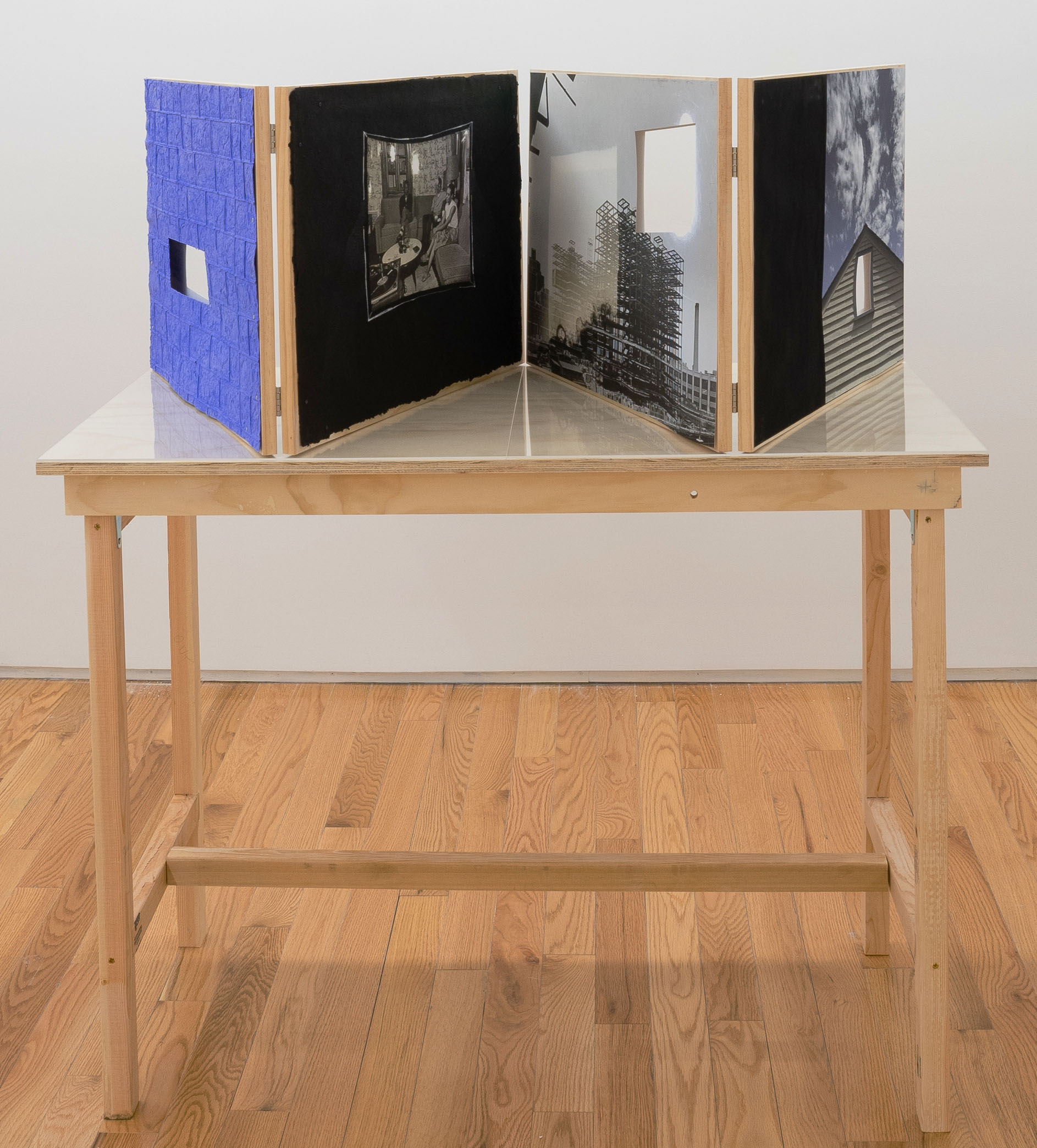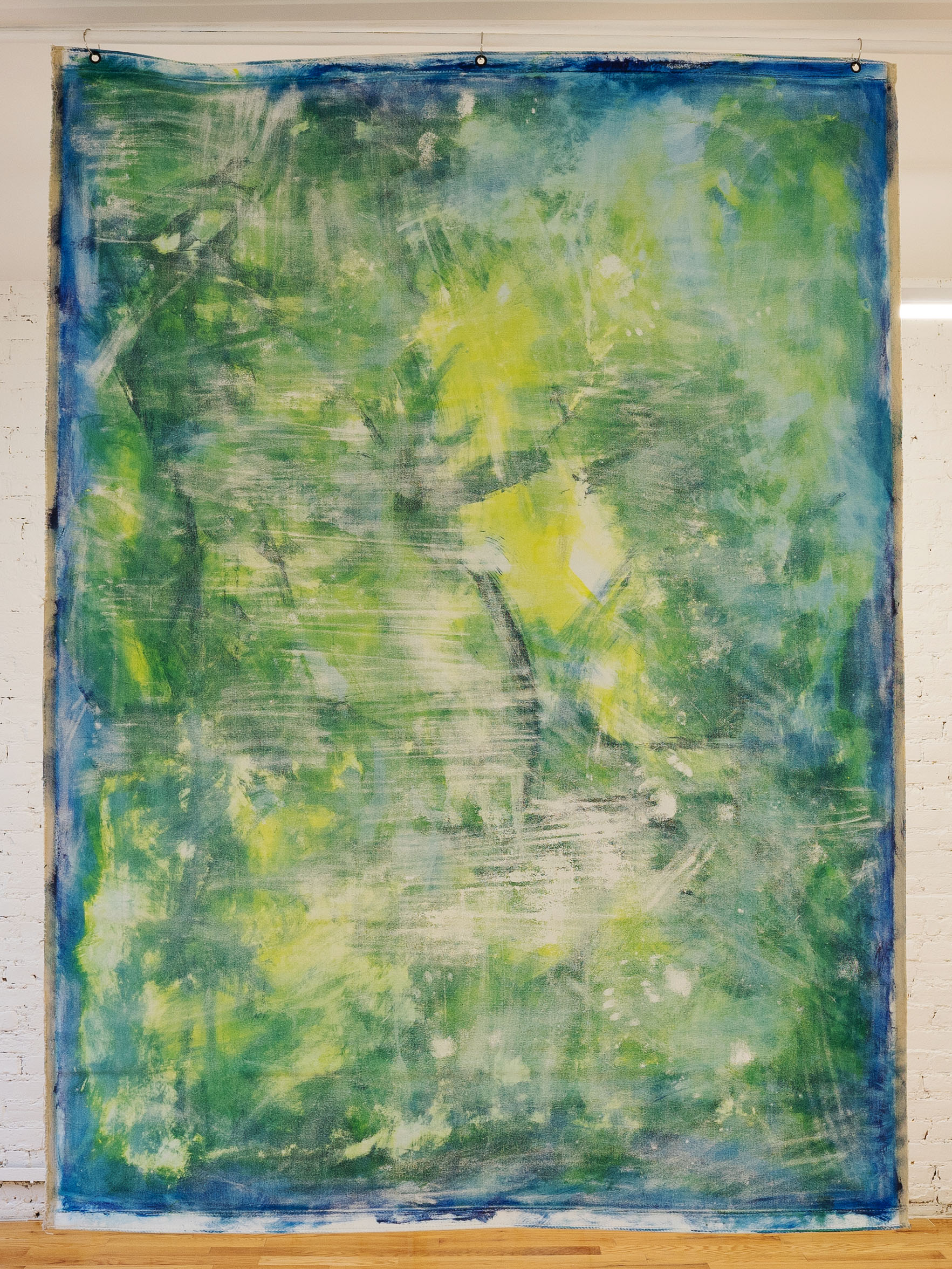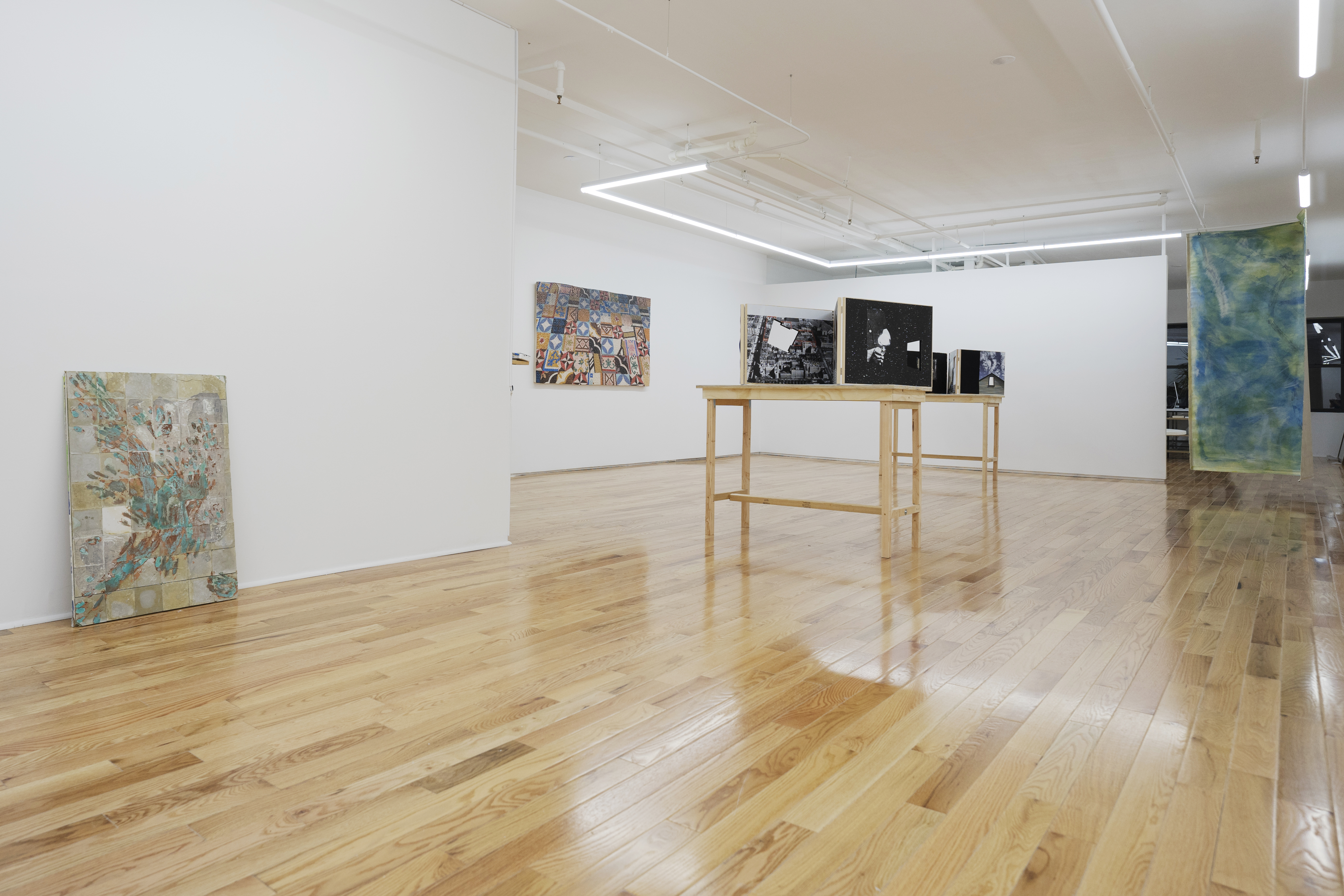formerly: Rubber Factory
full archive here
full archive here
ideal acre
Adam de Boer | Alex Callender | Adriana Furlong | Hings Lim
January 28 – March 04, 2023








island is pleased to present a group show titled, ideal acre, with works by Adam de Boer, Adriana Furlong, Alex Callender and Hings Lim.
The show draws its title from Alex Callender’s research at the Schomburg Center for Research in Black Culture where she found an archive of architect and urban planner Joseph Black’s writings on “Ideal Acre Development” from the 1970s. It posited a theory of architecture and urban design that was unmoored from the European ideals and imagined an architecture that was sensitive towards and tailored to the needs of the black community. Apart from Black’s writings, Alex looked through hundreds of tenant building complaints and relocation forms that tell the decades long story of slum clearance, relocation, and mid-century modern housing programs, which effectively produced the segregated urban and suburban corridors we live in today. Working from the Schomburg library collection, her project foregrounds narratives from tenant-based organizations, labor groups, and local agencies to tell the story of federal housing policy and community resistance to renewal and relocation programs. Alex started this research to better understand the 1949 Housing Act and the FHA mortgage system that created two radically different outcomes to American housing access and the promises of public investment, which have resulted in our current housing crisis. Her works in ideal acre scaffold images and texts from these archives into a porous installation that is infused with Alex’s own drawings.
Where does architecture end and housing begin? This seems to be an overarching question that many works in ideal acre are charged with. Adriana Furlong’s works are materially complex, deriving from offcuts and scraps collected from construction sites, salvage yards and metal shops. Adriana also incorporates blueprints from the 1948 edition of American Builders: Blueprint Series, where the quarterly presented low cost schemas for housing. These post-war designs and ideals become illegible in Adriana’s works as overlaid rusted copper tones and hand-made tiles obscure details and tend towards incompleteness. Peeling away the exoskeleton of buildings, Adriana seeks covert gestures rendered by hands stippling surfaces to investigate how the body exists within structures ever in flux. Her work reminds us that the utopian impulse leaves ephemeral residues behind, a residue of memory. By amplifying the traces of those who handled, breathed, and made the materials, Adriana generates an organizing schema of a new urban architecture that remembers.
Adam de Boer paints observational landscapes from his Los Angeles studio, transforming sprawling cityscapes into tidy, hard-edged blocks of color through wax reliefs made in the traditional Indonesian batik technique. In “Rosemead Reflection”, a highway and the hills in the distance are mirrored in the glassy facade of an anonymous LA office building with a few cursory palm trees. Using the batik technique, which is used primarily for textiles, the vernacular of urban sprawl is reclaimed into a more domestic space. The seeming contradiction is a by-product of Adam’s own experience as a Eurasian who has traveled throughout Indonesia, studying its histories and craft techniques. The other work in the show, “Tegel Buitenzorg”, is based on the floor of his studio in Yogyakarta, Indonesia. The painting, made atop a traditional ‘tikar’ floor mat of hand-woven pandan leaves, depicts a jumbled arrangement of salvaged so-called ‘Portuguese’ tiles. These pressed cement tiles, made from volcanic ash, are actually English in origin, and were introduced to Indonesia by the Dutch to bring hygienic surfaces to the colonies. Featuring imagery and designs from around the globe, they are, in fact, a sanitized visual index of European colonial projects. The loaded signs and symbols contained within them form a story about colonial conquests, religious expansions and exported histories of beauty. In effect, the piece contains two distinct surfaces, the physical relief of the pandan weaving and the painted illusion of the tiles. The juxtaposition calls into question distinctions between high and low, local and foreign, handmade craft and mechanical production. “Tegel Buitenzorg” captures these tiles in their latest incarnation, reclaimed by contemporary Javanese builders for their utility; their original power subverted in service of the contemporary home.
For the series “Cleaning,” Hings Lim hired Malaysian cleaners, a workforce often defined by its invisibility. Centering the workers’ bodies within the nexus of the house, he casts a spotlight on the normally hidden labor that is needed to maintain it. Large urban centers, such as the one in Kuala Lumpur, Malaysia, require a large populace of low waged workers to maintain their unsustainable role as markers of modernity. A house is a home to some, a work place to others. Implicit within the works seems to be a question by the artist: is there a difference between a mark laid by an artist versus a mark left by a cleaner? In this work, Hings adopts the intimate, domestic scale of a small house, using intricate mark-making as an embodiment for utopic ideals of cleanliness. These large canvases have a topographical scale, they unfurl into room-sized installations which recall a network of roads or a blurred vision of a busy urban crossing. In the context of ideal acre, the pieces are direct contributions by non-artists, they represent the bodies often subsumed by the system.
Adam de Boer graduated with a BA in Painting from the College of Creative Studies at the University of California, Santa Barbara (2006) and an MA in Fine Art from the Chelsea College of Art, London (2012). Recent exhibitions include Gajah Gallery, Jakarta and Singapore (2023, 2022); Ben Brown Fine Arts, London and Hong Kong (2022); Taymour Grahne Projects, London (2022); The Hole, New York and Los Angeles (2022, 2023); Hunter Shaw Fine Art, Los Angeles (2020/2018); World Trade Centre, Jakarta (2018); and Art|Jog, Yogyakarta (2018/2015). De Boer is currently a Joan Mitchell Foundation Fellow and in 2017 was awarded a Fulbright Research Fellowship to Java, Indonesia. Other grants include those from the University of the Arts, London + Arts for India, The Cultural Development Corporation, DC Commission on the Arts and Humanities, and The Santa Barbara Arts Fund. For over a decade de Boer has traveled throughout Indonesia to investigate his Eurasian heritage. His recent work employs imagery and traditional crafts from the region as a way to connect his artistic practice with those of his distant cultural forebears. He currently lives in Los Angeles.
Alex Callender’s studio practice incorporates painting, drawing, and installation to explore intersections between myth, colonial legacies, and material culture. Through the visual forms of historical narrative, repurposed archival imagery, and speculative fictions, she considers questions of race and borders, environmental instability, and hybridized landscapes. Callender has exhibited nationally and internationally, and has held studio residencies with the Lower Manhattan Cultural Council, The Drawing Center’s Open Session program, the Art in Embassies Program, Santa Fe Art Institute, The Vermont Studio Center, Urban Glass, the Santa Fe Art Institute, Alice Yard in Trinidad, and DRAWinternational and The BAU Institute in France. Raised in New York City, Callender now lives in western Massachusetts and is an Assistant Professor of Art at Smith College, she will be a researcher-in-residence at the Schomburg Center in New York, Fall 2021.
Adriana Furlong (b. Berkeley, CA) is a visual artist and writer based in New York City. She works between vernacular and notational history to excavate those residual memories, bodies and narratives that have been forgotten, lost and buried. Furlong’s work has been included in several group exhibitions in New York, most recently “as built/as made “ at Undercurrent Gallery, (January 2022). Her work has been reviewed by Musee Magazine, and Teeth Magazine. She is a regular contributor to The Brooklyn Rail among other publications.
Hings Lim (b. 1989, Malaysia) is an interdisciplinary artist living and working in Los Angeles. He works in an expanded use of mediums that includes video, installation, sculpture, performance, simulation, and situation. His process-oriented practice probes the formation of apparatuses, while addressing the multiplicities between historicity, performativity, materiality, and subjectivity of things and their becoming. He completed a Master of Fine Arts degree and the Performance Studies Graduate Certificate at the University of Southern California, Los Angeles in 2021, as a recipient of the USC International Artist Fellowship; and a Bachelor of Fine Arts degree from the Universiti Malaysia Sarawak, Malaysia in 2012. He is a recipient of the Petronas – P. Ramlee Chair’s Award in 2012 and completed the Southeast Asian Artist Residency Program at Rimbun Dahan, Selangor, Malaysia in 2018. Selected group exhibitions include ‘The Tale Their Terror Tells’, Lyles & King, New York; ‘Don’t Look Now’, Human Resources, Los Angeles; ‘Wonderland’, EPOCH Gallery, Los Angeles; ‘GLAMFA 2020: Double Play’, CSU Long Beach Art Galleries, Long Beach, California; ‘Young Contemporaries Award’, National Art Gallery, Kuala Lumpur; ‘Art Stage Singapore’, Singapore; and ‘Malaysian Art: A New Perspective’, Richard Koh Fine Art, Kuala Lumpur. He was one of the founders of Lattalilat, a community art project, and exhibited at National Art Gallery, Kuala Lumpur; MIA College Gallery, Kuala Lumpur; FACA Gallery, Sarawak; and Muzium & Galeri Tengku Fauziah, Penang, Malaysia. He is currently an artist-in-residence at Grand Central Art Center, Santa Ana, California, supported in part by The Andy Warhol Foundation for the Visual Arts.
The show draws its title from Alex Callender’s research at the Schomburg Center for Research in Black Culture where she found an archive of architect and urban planner Joseph Black’s writings on “Ideal Acre Development” from the 1970s. It posited a theory of architecture and urban design that was unmoored from the European ideals and imagined an architecture that was sensitive towards and tailored to the needs of the black community. Apart from Black’s writings, Alex looked through hundreds of tenant building complaints and relocation forms that tell the decades long story of slum clearance, relocation, and mid-century modern housing programs, which effectively produced the segregated urban and suburban corridors we live in today. Working from the Schomburg library collection, her project foregrounds narratives from tenant-based organizations, labor groups, and local agencies to tell the story of federal housing policy and community resistance to renewal and relocation programs. Alex started this research to better understand the 1949 Housing Act and the FHA mortgage system that created two radically different outcomes to American housing access and the promises of public investment, which have resulted in our current housing crisis. Her works in ideal acre scaffold images and texts from these archives into a porous installation that is infused with Alex’s own drawings.
Where does architecture end and housing begin? This seems to be an overarching question that many works in ideal acre are charged with. Adriana Furlong’s works are materially complex, deriving from offcuts and scraps collected from construction sites, salvage yards and metal shops. Adriana also incorporates blueprints from the 1948 edition of American Builders: Blueprint Series, where the quarterly presented low cost schemas for housing. These post-war designs and ideals become illegible in Adriana’s works as overlaid rusted copper tones and hand-made tiles obscure details and tend towards incompleteness. Peeling away the exoskeleton of buildings, Adriana seeks covert gestures rendered by hands stippling surfaces to investigate how the body exists within structures ever in flux. Her work reminds us that the utopian impulse leaves ephemeral residues behind, a residue of memory. By amplifying the traces of those who handled, breathed, and made the materials, Adriana generates an organizing schema of a new urban architecture that remembers.
Adam de Boer paints observational landscapes from his Los Angeles studio, transforming sprawling cityscapes into tidy, hard-edged blocks of color through wax reliefs made in the traditional Indonesian batik technique. In “Rosemead Reflection”, a highway and the hills in the distance are mirrored in the glassy facade of an anonymous LA office building with a few cursory palm trees. Using the batik technique, which is used primarily for textiles, the vernacular of urban sprawl is reclaimed into a more domestic space. The seeming contradiction is a by-product of Adam’s own experience as a Eurasian who has traveled throughout Indonesia, studying its histories and craft techniques. The other work in the show, “Tegel Buitenzorg”, is based on the floor of his studio in Yogyakarta, Indonesia. The painting, made atop a traditional ‘tikar’ floor mat of hand-woven pandan leaves, depicts a jumbled arrangement of salvaged so-called ‘Portuguese’ tiles. These pressed cement tiles, made from volcanic ash, are actually English in origin, and were introduced to Indonesia by the Dutch to bring hygienic surfaces to the colonies. Featuring imagery and designs from around the globe, they are, in fact, a sanitized visual index of European colonial projects. The loaded signs and symbols contained within them form a story about colonial conquests, religious expansions and exported histories of beauty. In effect, the piece contains two distinct surfaces, the physical relief of the pandan weaving and the painted illusion of the tiles. The juxtaposition calls into question distinctions between high and low, local and foreign, handmade craft and mechanical production. “Tegel Buitenzorg” captures these tiles in their latest incarnation, reclaimed by contemporary Javanese builders for their utility; their original power subverted in service of the contemporary home.
For the series “Cleaning,” Hings Lim hired Malaysian cleaners, a workforce often defined by its invisibility. Centering the workers’ bodies within the nexus of the house, he casts a spotlight on the normally hidden labor that is needed to maintain it. Large urban centers, such as the one in Kuala Lumpur, Malaysia, require a large populace of low waged workers to maintain their unsustainable role as markers of modernity. A house is a home to some, a work place to others. Implicit within the works seems to be a question by the artist: is there a difference between a mark laid by an artist versus a mark left by a cleaner? In this work, Hings adopts the intimate, domestic scale of a small house, using intricate mark-making as an embodiment for utopic ideals of cleanliness. These large canvases have a topographical scale, they unfurl into room-sized installations which recall a network of roads or a blurred vision of a busy urban crossing. In the context of ideal acre, the pieces are direct contributions by non-artists, they represent the bodies often subsumed by the system.
Adam de Boer graduated with a BA in Painting from the College of Creative Studies at the University of California, Santa Barbara (2006) and an MA in Fine Art from the Chelsea College of Art, London (2012). Recent exhibitions include Gajah Gallery, Jakarta and Singapore (2023, 2022); Ben Brown Fine Arts, London and Hong Kong (2022); Taymour Grahne Projects, London (2022); The Hole, New York and Los Angeles (2022, 2023); Hunter Shaw Fine Art, Los Angeles (2020/2018); World Trade Centre, Jakarta (2018); and Art|Jog, Yogyakarta (2018/2015). De Boer is currently a Joan Mitchell Foundation Fellow and in 2017 was awarded a Fulbright Research Fellowship to Java, Indonesia. Other grants include those from the University of the Arts, London + Arts for India, The Cultural Development Corporation, DC Commission on the Arts and Humanities, and The Santa Barbara Arts Fund. For over a decade de Boer has traveled throughout Indonesia to investigate his Eurasian heritage. His recent work employs imagery and traditional crafts from the region as a way to connect his artistic practice with those of his distant cultural forebears. He currently lives in Los Angeles.
Alex Callender’s studio practice incorporates painting, drawing, and installation to explore intersections between myth, colonial legacies, and material culture. Through the visual forms of historical narrative, repurposed archival imagery, and speculative fictions, she considers questions of race and borders, environmental instability, and hybridized landscapes. Callender has exhibited nationally and internationally, and has held studio residencies with the Lower Manhattan Cultural Council, The Drawing Center’s Open Session program, the Art in Embassies Program, Santa Fe Art Institute, The Vermont Studio Center, Urban Glass, the Santa Fe Art Institute, Alice Yard in Trinidad, and DRAWinternational and The BAU Institute in France. Raised in New York City, Callender now lives in western Massachusetts and is an Assistant Professor of Art at Smith College, she will be a researcher-in-residence at the Schomburg Center in New York, Fall 2021.
Adriana Furlong (b. Berkeley, CA) is a visual artist and writer based in New York City. She works between vernacular and notational history to excavate those residual memories, bodies and narratives that have been forgotten, lost and buried. Furlong’s work has been included in several group exhibitions in New York, most recently “as built/as made “ at Undercurrent Gallery, (January 2022). Her work has been reviewed by Musee Magazine, and Teeth Magazine. She is a regular contributor to The Brooklyn Rail among other publications.
Hings Lim (b. 1989, Malaysia) is an interdisciplinary artist living and working in Los Angeles. He works in an expanded use of mediums that includes video, installation, sculpture, performance, simulation, and situation. His process-oriented practice probes the formation of apparatuses, while addressing the multiplicities between historicity, performativity, materiality, and subjectivity of things and their becoming. He completed a Master of Fine Arts degree and the Performance Studies Graduate Certificate at the University of Southern California, Los Angeles in 2021, as a recipient of the USC International Artist Fellowship; and a Bachelor of Fine Arts degree from the Universiti Malaysia Sarawak, Malaysia in 2012. He is a recipient of the Petronas – P. Ramlee Chair’s Award in 2012 and completed the Southeast Asian Artist Residency Program at Rimbun Dahan, Selangor, Malaysia in 2018. Selected group exhibitions include ‘The Tale Their Terror Tells’, Lyles & King, New York; ‘Don’t Look Now’, Human Resources, Los Angeles; ‘Wonderland’, EPOCH Gallery, Los Angeles; ‘GLAMFA 2020: Double Play’, CSU Long Beach Art Galleries, Long Beach, California; ‘Young Contemporaries Award’, National Art Gallery, Kuala Lumpur; ‘Art Stage Singapore’, Singapore; and ‘Malaysian Art: A New Perspective’, Richard Koh Fine Art, Kuala Lumpur. He was one of the founders of Lattalilat, a community art project, and exhibited at National Art Gallery, Kuala Lumpur; MIA College Gallery, Kuala Lumpur; FACA Gallery, Sarawak; and Muzium & Galeri Tengku Fauziah, Penang, Malaysia. He is currently an artist-in-residence at Grand Central Art Center, Santa Ana, California, supported in part by The Andy Warhol Foundation for the Visual Arts.
